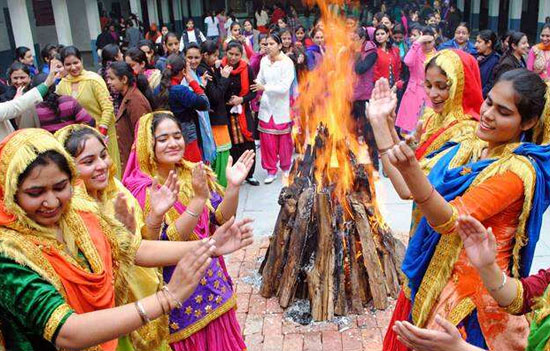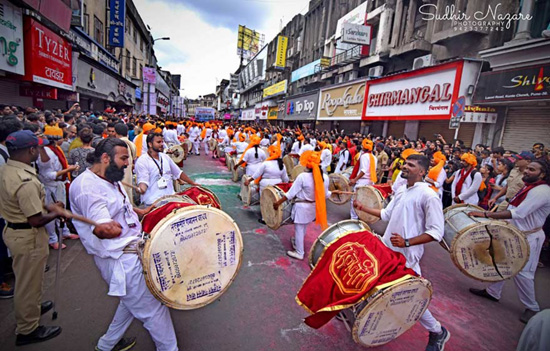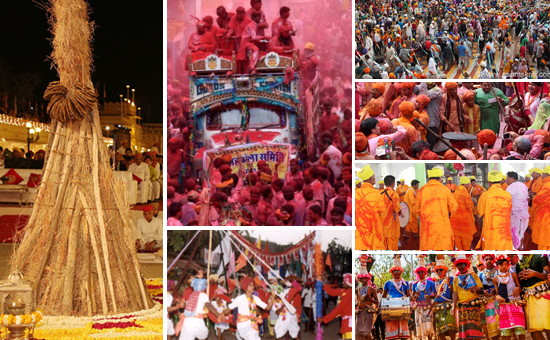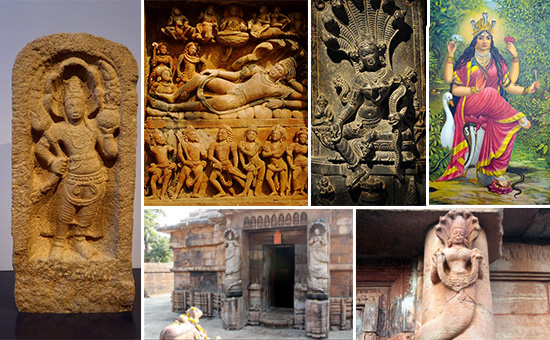- Know about the agrarian roots of Indian festivals and how celebration
of Nagapanchami kills pests. Bharatiya Festivals are expressions of culture,
celebration that also strengthen family bonds. They also mark changing seasons.
Bharat, a land of staggering diversity, celebrates festivals for every
reason and every season. These festivals are the expressions of a culture that
lives in a state of perpetual celebration. They are the moments when the
mundane transcends into the magnificent, bringing life to a state of exuberance
and enthusiasm.
Each festival here weaves together stories of the past with the
aspirations of the present.
The festivals are as varied as the people themselves, celebrating
everything from the bounty of harvests to the memories of historical legends,
and from the reverence for deities to the cycles of the moon and sun. Homes
come alive with lights and colors, new garments add splendor to the gatherings,
and the air resonates with the melodies of music and the rhythm of dance steps.
Feasting tables unite families and friends, as every festival becomes a
momentous occasion to rejuvenate the bonds and share joy.
In Bharat, festivals are not just days on a calendar; they are exuberant expressions of a culture that cherishes every shade of life’s palette.
Yet, the essence of these celebrations transcends mere merriment; they
are the heartbeat of a civilization that has always found reasons to rejoice.
The agrarian roots of the country turned every aspect of farming into a cause
for festivity-from the ploughing of fields to the sowing of seeds, and from the
meticulous care of the growing crops to the jubilance of the harvest. These
were the days when the entire culture was a continuous festival, each day a
chapter in an ongoing saga of life and labor.
However, the tides of time have brought changes. With the advent of
poverty over the centuries, the daily festivities waned, leaving behind only
the most significant ones to be celebrated. Yet, even as the number of
festivals has diminished, their spirit remains undiminished, reminding us of
the resilience and eternal optimism that define the Indian ethos
In the rich culture of Bharatiya civilization, festivals, also known as Parva hold a place of profound significance. These celebrations, known as Parva, are deeply rooted in the agrarian traditions of Bharat. Parvas are not mere markers of time but the rhythm of an agrarian society's heartbeat.
The very essence of
Bharatiya society has been woven around its agricultural practices, with
festivals marking the rhythms of the agricultural calendar.
Bharatiya civilization has fulfilled its Dharma as an agrarian society by intricately linking the concepts of space and time with rain, a vital component for agriculture. The word "Varsha" in Sanskrit, intriguingly, means rain, year, and land, underscoring this intrinsic connection. This linguistic unity reflects how deeply entwined agriculture and natural cycles are with the cultural and temporal understanding in Bharat.
 Lohri celebrations.
Lohri celebrations.
Hindu festivals, or Parva, are more than mere celebrations; they are a
testament to the deep connection between Bharatiya civilization and its
agrarian roots. These festivals not only mark the passage of time and the
changing seasons but also reinforce the harmonious relationship between humans
and nature. Through these vibrant celebrations, the wisdom of the ancients
continues to guide modern agricultural practices, ensuring that the cycle of life,
growth, and harvest remains unbroken.
Parva in Jyotisha
The term 'Parva' in Jyotisha signifies the sacred conjunctions and oppositions of the Sun and Moon, the full and new Moon tithis, and the eclipses. In the Bhutasankhya representation system, it represents the number five, denoting the five auspicious days in a month—Amavasya, Purnima, Krishna paksha Ashtami, Krishna paksha Chaturdashi, and Sankranti.
These days are not
just dates on a calendar but the confluence of divine energies.
Parva is the act of joining, the association of time and space with the
spirit of humanity. It is the node in the stem of life, where the physical and
metaphysical meet. It is the period when performing sacred ceremonies yields
the highest merit.
The root meaning of ‘Parva’ beautifully captures the essence of festivals in Indian culture. The word ‘Parva’ signifies the act of joining or associating, which resonates with the way festivals bring people together, fostering a sense of community and shared experience. Just as a node (or joint) on a plant stem signifies a point of connection and growth, festivals serve as pivotal moments that connect various aspects of life—spiritual, social, and agricultural.
In the context of festivals, ‘Parva’ can be seen as a time when the celestial and the terrestrial, the divine and the human, the past and the present, all converge. It is an association not just between people, but also between people and the divine, the earth, and the cosmos.
This convergence is celebrated through rituals, prayers, and communal activities that mark the festival’s significance.
 Magh Bihu celebrations in Assam.
Magh Bihu celebrations in Assam.
Moreover, just as a node on a plant is a critical point that supports new growth and branching, festivals are moments that strengthen cultural roots and encourage the blossoming of community spirit. They are points in time that allow for reflection, renewal, and the nurturing of bonds within the community. In this way, ‘Parva’ as a concept goes beyond the literal meaning to embody the deeper connections that festivals foster within society.
Bharat boasts a variety of calendars, reflecting its diverse cultural
and regional traditions. Some of these are lunar-based, some are solar-based,
and others are luni-solar, blending both lunar and solar calculations. This
multiplicity of calendars mirrors the complexity and richness of Bharatiya
cultural practices, each attuned to the agricultural and climatic variations of
their regions.
The Role of Agriculture
Agriculture has been the cornerstone of Bharatiya civilization, with
the agricultural calendar dictating the timing of festivals and cultural
practices. The year and its months were defined by agricultural activities:
sowing, harvesting, accounting, cleaning, and resting. These activities (achara) practised in specific time (Kaala) collectively shaped the kalachara (culture) of Bharatavarsha.
Seasonal Agriculture and Traditional Knowledge
Seasonal agriculture mirrors the cycle of life itself—from seed to flower to seed, encapsulating an entire generation within a single season. It is the seed that bridges generations, ensuring the continuity of life and tradition.
 Ganesh Chaturthi celebrations in Pune.
Ganesh Chaturthi celebrations in Pune.
In Bharatiya tradition, agriculture is seen in two main aspects:
Seasonal Agriculture: This
type of agriculture completes its cycle within one season, with plants living
for one season alone. The seed acts as a bridge between two generations of crop
cycles.
Perennial Agriculture: Some
crops grow throughout the year, providing a steady supply of produce.
 Holi is celebrated across India but in different ways, so is Dussehra.
Holi is celebrated across India but in different ways, so is Dussehra.
Some major festivals tied to agricultural cycles include
1. Deepavali (Diwali): Celebrated in October/November, it follows the
harvest season and is a time of joy.
2. Sankranti, Pongal, Bihu, Lohri: These festivals, celebrated in
January, mark the harvest season and are times of communal feasting and
merriment.
3. Ugadi: Celebrated in April, it marks the beginning of the new year in
some regions and is associated with deep ploughing of land. On this day, people
take baths with neem leaves, believed to have medicinal properties.
4. Holi: The festival of colors in March, it signifies the end of winter
and the beginning of the spring harvest.
5. Nagapanchami: Celebrated in August, this festival emphasizes soil health. Raw milk
and ghee are poured into termite mounds in honor of the snakes, attracting ants
that help improve soil quality.
But, what about the summer?
It is a season of anticipation, where the land and its people await the monsoon's rejuvenating embrace. It is a time of preparation, where the seeds of tomorrow's bounty are sown in the womb of the earth.
Traditional knowledge in Bharatiya society has been passed down through
generations via oral traditions, myths, proverbs, folklore, legends, rituals,
songs, arts, and even laws. This
accumulated wisdom reflects the practical effects of living in harmony with
nature.
Let us try to understand this in connection with the festival of
Nagapanchami, which is celebrated in Ashadha month (July-August). It is a
festival that exemplifies the harmonious relationship between traditional
farming practices and cultural festivities. It underscores the ancient wisdom
of integrating agricultural activities with religious observance to sustain and
enhance soil health, which is vital for a successful harvest.
 Snakes are worshipped in India.
Snakes are worshipped in India.
During Nagapanchami, farmers pour raw milk
and ghee onto soil bunds constructed by termites, as an offering to the
Nagas-snakes. This practice is not merely a religious ritual but serves
a dual purpose. The offering attracts a variety of ants to the fields. These
ants, in turn, play a crucial role in pest control by helping to manage the
termite population, which can be particularly problematic during the harvesting
season. By controlling termites naturally, the ants aid in preserving the
integrity of the soil and the crops.
Furthermore, after the harvest, farmers traditionally construct bunds
in their fields. These bunds are not only effective in water retention and soil
conservation but also act as a preventive measure against termite infestation.
The creation of bunds is a proactive step that reflects the ingenuity of
traditional farming methods.
Similar to Nagapanchami which is a prime example of how festivals are
intricately linked to farming practices there are several others which showcase
a sustainable approach to agriculture that respects and utilizes biodiversity,
aligning religious devotion with ecological stewardship- all done during
festivals.
Let us rediscover the essence of 'Parva,' and rekindle the spirit of celebration that is the hallmark of Bharatiya culture. Let us celebrate these festivals, not just treat them as days of observance but as the vibrant pulsations of an agrarian legacy that continues to enrich our lives.
Author Dr Ketu Ramachandrasekhar is co-founder
of Bharat ke Wow and course developer at Siddhanta Knowledge Foundation. He is
also an expert panel member in Sangeet Natak Akademi. He has his Doctorate in
Indian Epistemology and was selected as a Fellow from hundred young scholars
across India for Studies in Neuro Aesthetics and Indian Rhetoric by Ministry of
Culture, GOI. He was a part of Academic Team of scholars across Europe on
discussion of Natya Texts. His expertise in Tantrashastra and Shaiva
Pratyabhijna School is well recognised. He has several research articles and
books to his credit which includes a detailed study of Abhinayadarpana of
Nandikeshvara, Devi Mahatmya and others.
To read all articles by author
To read all articles on Indian Festivals
Also read
1. Durga
Puja is widely celebrated across Bharat
2. How
Dussehra is celebrated across India
3. How
Holi is celebrated across India
4. Significance
of Lohri and how celebrated
5. Ringing
in Tamil New Year
6. Bonfires
of Magh Bihu
7. Why
is Onam celebrated
8. Worship
of Snakes in India